|
THE VERY FIRST SOLO BLIND FLIGHT
Albert F. Hegenberger was born September 30, 1895 and died
in Florida on August 31, 1983. He graduated from MIT with
a degree in aeronautical engineering. He was well-equipped
for his stellar career in aviation.
He signed
into the Davis-Monthan Register as a passenger on June
20, 1927. He was flying with Lester
Maitland and
they were on their way to San Francisco to begin a flight
that would take them across the Pacific Ocean to Hawaii.
They would be the first pilots to do so.
Please follow this link to view a short motion
picture clip of Hegenberger and Maitland with their airplane on the ground at Tucson.
Their airplane was an Army Fokker
C-2 trimotor transport, 26-202, specially outfitted, strengthened
and equipped for the flight. They wrote "Honolulu
or bust" in the remarks column of the Register. Click here to
see an image of Hegenberger and Maitland on this site when
they stopped at Tucson. This image most certainly was taken
near the time of filming the motion picture above. They
did make it to Wheeler Field, Oahu on June 29, 1927 in 25 hours and 43 minutes. Hegenberger
and Maitland received the Distinguished Flying Cross for
their flight. Below, courtesy of site visitor Roger Holden, Hegenberger sits at the radio table in 26-202. Note the wet cell battery and the light-weight wicker chair.
Albert Hegenberger at the Radio Table in Fokker 26-202, Date & Location Unknown (Source: Holden)
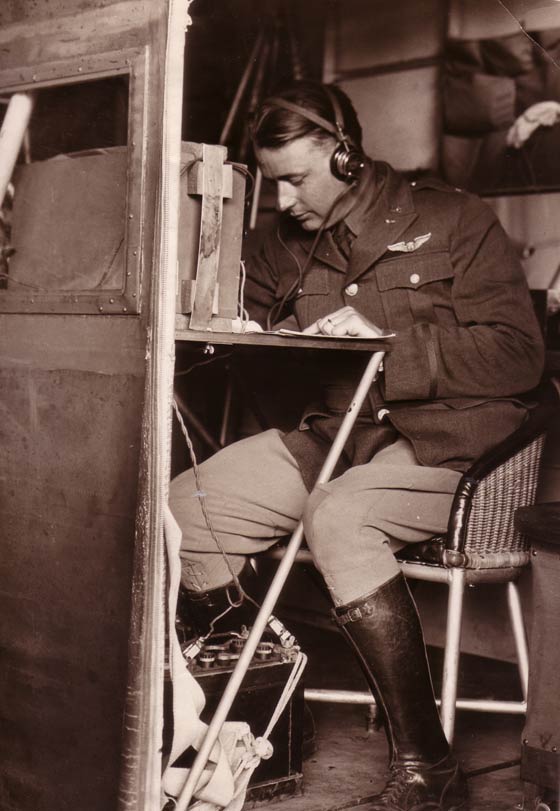 |
Below, a succinctly tabulated artifact from the trans-Pacific
flight, found in the NASM dossier cited in the left sidebar.
It is their flight log, with timing and positional information,
hand-written by Hegenberger. Imagine today, in the age of the satellite-based Global Positioning System, traversing
2,400 miles of open ocean based on your "most probable fix".
If you are a navigation buff, you'll enjoy this raw, Golden
Age treasure.
Flight Log for the Trans-Pacific Flight
 |
Hegenberger and Maitland were the first ones successfully to fly all the way across the Pacific (a Navy team in flying boats made the attempt in 1925, landed in the water 450 miles short of Hawaii, and sailed the rest of the way). They were soon followed by two civilian teams. First, Ernest L. Smith and Emory Bronte flew a Travel Air across on July 14, 1927.
The link states that Maitland and Hegenberger had returned from Hawaii before Smith and Bronte departed, and that, "... when Smith signaled his readiness to take off that July 14 morning. Maitland and Hegenberger had come to the field and wished their former rivals luck." Below, we see Hegenberger on the left with Smith, probably during those good luck wishes. Although the photo is dated July 20th, the caption says, "Lieut. Albert Hegenberger, who accompanied Lieut. Maitland, conquerors of the Pacific, walking with Ernest L. Smith just before the takeoff."
Albert Hegenberger (L) and Ernest L. Smith, July 20, 1927 (Source: Underwood)
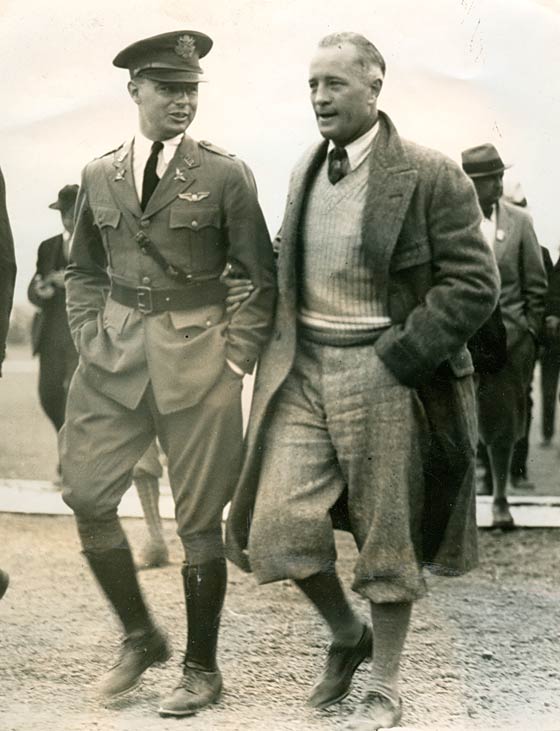 |
This moment in time, in photograph and caption, is shared with us by friend of dmairfield.org, John Underwood.
Caption, Albert Hegenberger and Ernest L. Smith, July 20, 1927 (Source: Underwood)
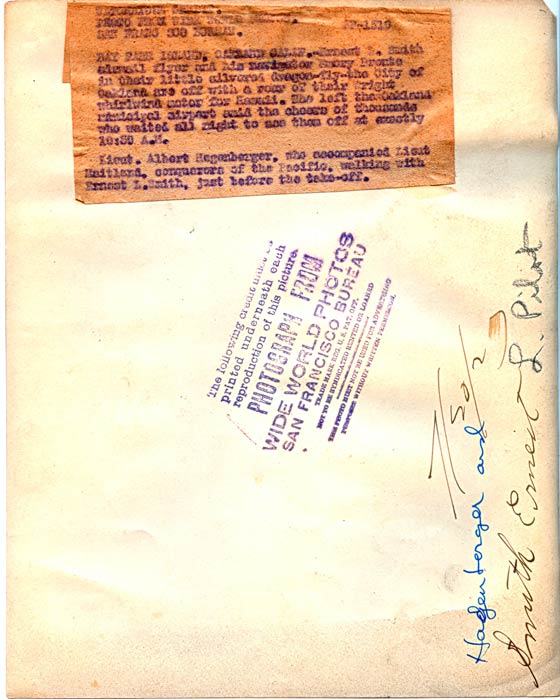 |
Second, on August 17, 1927, the team of Register pilot Art Goebel and William V. Davis, Jr. participated in and won the trans-Pacific Dole Race. Their flight is detailed in the book written by your Webmaster, "Winners' Viewpoints..." cited in the left sidebar. They and the second place airplane flown by Martin Jensen and Paul Schluter, were the only people to fly the Pacific during the 1920s. The next attempt was made during January 1935, when, successfully, it was made by Register pilot Amelia Earhart flying solo from west to east from Honolulu to San Francisco. It is significant that three of the four successful Pacific flights of the 1920s were flown by Register pilots.
Now back to Hegenberger. He is one of the many examples of Davis-Monthan
pilots who made significant contributions to the science
and practice of military aviation, with its attendant spinoffs
to civil flying. His trans-Pacific flight is a key contribution,
well-documented on the Web, and generally considered the
highlight of his career. In a minor sense, he coined a word that us used today to describe the intimate connection between navigation and aviating. The word is "avigation." The following from the Bureau of Aeronautics Newsletter of November 30, 1927 reports.
Bureau of Aeronautics Newsletter, November 30, 1927 (Source: Webmaster)
 |
However, less appreciated but more
impactful to this day, on May 9, 1932 Hegenberger piloted
the very first official solo blind instrument flight. The key
words here are 'official' and 'solo'. Let me explain. Earlier, in 1926 Howard
Stark developed his "1-2-3 System" of blind flying
by reference to the turn coordinator (see page 9 of the Miller
reference in the left sidebar). According to Miller, Stark
flew many unofficial, straight and level blind flights over
the Connecticut hills carrying mail between New York
and Boston. His primary instrument to give him horizontal reference was his turn coordinator. Even though the enroute sections of the flights were performed blind, the takeoffs and landings were in visual conditions.
Likewise, in September 1929 Jimmy Doolittle flew
an airplane from the ground, around a planned course, and
returned it successfully to a landing by reference to instruments
alone (it was a fair-weather day and he was under a canvas
hood and could not see out of the cockpit). But, he had a
check pilot with him in the other cockpit who could see. Doolittle flew on a clear day and was not solo.
Hegenberger, however, withstood the hammer test by making
his 'official' 1932 flight 'solo.' The flight was documented in Popular Aviation, March, 1934 (PDF 1.9Mb) at the link. Note that the article suggests that Hegenberger also flew under a hood over the cockpit, but he was solo. If you are an instrument-rated pilot and read this article, you will be amused at how little changed over the years regarding the mechanism of the instrument approach. Use of Global Positioning System satellites has changed everything now, but the principles still apply.
Hegenberger's feat is further documented simply and tersely on a page from
his pilot log, preserved in his dossier at the National Air
& Space Museum. This (image below) is how it was noted:
May 9, 1932 First Solo Instrument Flight Logged
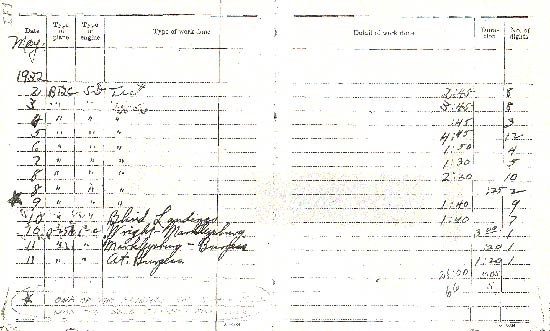 |
The key wordings on this image are difficult to read, but
his star indicates the date of the first solo instrument
flight. The starred and circled footnote, barely readable on the original,
says: "One
of the [nine] flights on 9 May 1932 was the solo flight.
First ever."
Take
another good look at this image, ladies and gentlemen. It
documents and represents a profound turning point in aerial science and
practice. Before the star, all flight was dependent upon
good visibility. After the star, we ventured alone into clouds
with impunity. And so it was, recorded tersely in the flight log of a modest pilot.
Lest you think the Army didn't recognize the importance, below is a page and a half spread dedicated to Hegenberger's flight that appeared in the popular Air Corps Newsletter of May 28, 1932. I spliced the pages together using PhotoShop. If you'd like a hard copy of the article to study, it's at the link (PDF, 2Mb).
Air Corps Newsletter, May 28, 1932 (Source: Web)
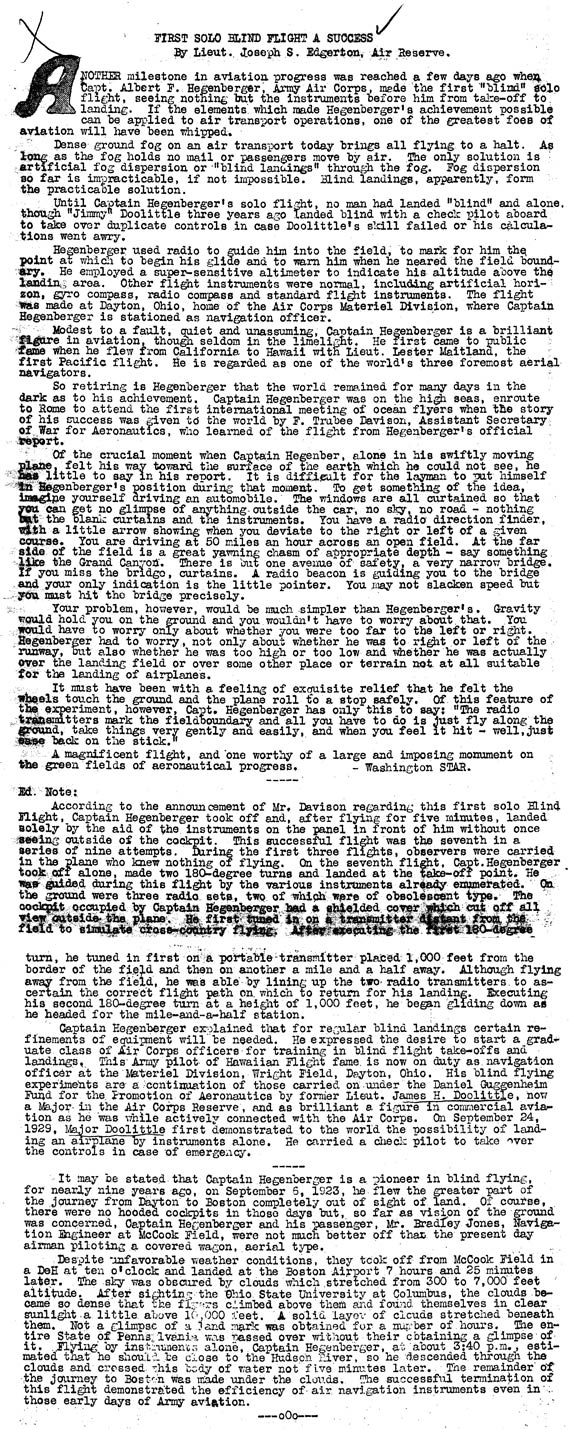 |
To be sure, this event was not an overnight accomplishment.
Hegenberger began his efforts to understand the needs, requirements
and technologies of military instrument flying back in 1918.
Through years of incremental experimentation and refinement
he brought the system to an operational point in 1933 where
it was installed at four Army flying fields. Two classes
of flying officers were trained on its use (under the order
and support of B.D.
Foulois, then Chief
of the Air Corps). The officers received it enthusiastically.
Collier Trophy Award, Popular Aviation, November, 1935 (Source: PA)
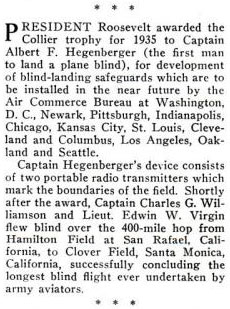 |
Although the development of the system took over a decade,
its deployment was very rapid after its value, robustness
and safety were proven. The second of the two classes of
instrument-trained officers was deployed to the four Army
fields to act as instructors for other pilots. Register pilot Robert Henderson was one of the instructors responsible for rolling out the training.
By September
1934 the military was inviting, via an intense public relations program
through the Department of Commerce (see Register pilot Gilbert Budwig to understand the DOC's early interest in this program), civilian
air lines to send selected groups, including operations and
technical personnel as well as pilots, to Patterson Field
in Dayton, OH to participate in individual demonstrations
of the system. It was rolled out rapidly to airways and airfields
that formed the early network of commercial air transport
across the country.
A Blind Landing Award
The Collier Trophy has been awarded
to Capt. Albert F. Hegenberger, for his
work in perfecting blind-landing and
blind-flying systems based on the use
of the Fairchild-Kruesi "radio compass." |
In 1934 Hegenberger received the oak leaf cluster to his
Distinguished Flying Cross, and won the Collier Trophy for
his work with instrument flying. The article, above, left, from Popular Aviation (PA) magazine, November, 1935 documents the award of the Trophy by president Roosevelt.The brief "filler" article, right, appeared in the August 8, 1935 issue of the British journal Flight (p. 152).
Hegenberger was the second of seven
Davis-Monthan Register pilots and passengers to receive the Collier
trophy between 1921 and 1955, a brilliant testimony to the
competence of the people who signed our Registers so long
ago.
---o0o---
UPDATE OF 03/16/10 I read of an interesting passage in an oral history given by Register pilot Clarence M. Young in July, 1971. This passage gives evidence that another pilot, besides Howard Stark and Doolittle, flew under instrument conditions. Although the exact date is not clear from the transcript, it was probably near 1932. Does anyone KNOW?
In his transcript, Young stated that several Federal agencies,
COL . YOUNG: "... cooperated on the development of blind flying . It was demonstrated by one of our pilots, the late Jim Kinney. I went along as emergency pilot . He flew from Washington to Newark "under the hood", following a radio beam system that had been worked out, and landed at Newark Airport without having seen a thing.
MR . HENLE [the interviewer]: That early? Remarkable : What a brave young fellow he was.
COL. YOUNG: It was not so much bravery as it was skill, and the radio equipment that had been developed.
MR. HENLE: This was a pilot in the 1930s, during Mr. Hoover's Presidency, flying blind and seeing nothing -- seeing nothing except his instrument?
COL. YOUNG: Yes; otherwise I would not have been there as check pilot. On arrival at the airport there were two reporters, one from the New York Times and one from the New York Tribune. They knew we were coming in, and, being true reporters, they had to see it to believe it. So we invited each of them to take a quick trip as emergency pilot . They did and they were convinced of the efficacy of the instrument that first made "blind flying" possible. It has had some improvements through the years, but the principle is still the same.
MR. HENLE: That is a fascinating facet of this story. You were faced here with doing things that would increase public confidence in aviation.
COL . YOUNG: Yes. That was a primary objective all the way through . We realized that flying had to be demonstrated to be safe -- that there had to be rules, regulations, limitations, etc . By the time President Hoover left office in March 1933, the groundwork had been done in the way of lights, communications, instrument flying, with many men from all departments and bureaus contributing their time and energy to lay the foundation of what is now our airways system. |
---o0o---
Dossier 2.2.102
THIS PAGE UPLOADED: 01/14/07 REVISED: 04/02/07,11/19/08, 01/24/09, 03/06/10, 03/16/10, 02/01/11, 12/05/12, 06/30/14, 09/12/14
|









